M2 Internship proposal
Laboratoire Sciences et Ingénierie de la Matière Molle, (SIMM)
Address: ESPCI, 10 Rue Vauquelin 75005 Paris
Head: Etienne Barthel
Supervisors: M. Velay, J. Comtet

Figure. (A) Schematic of the experimental Single-Molecule fluorescence Microscopy set-up. The solid/liquid interface is selectively illuminated by an evanescent wave and imaged with a sensitive EMCCD camera. (B) Zoom on the local liquid melt structure, made of interacting polymeric molecules. Some polymers are tagged with a single fluorophore, allowing to follow their spatiotemporal trajectories. (C) Typical fluorescent signal on the EMCCD camera, with a single diffraction-limited spot related to the emitting fluorophore, localized and tracked with nanometric resolution and high temporal resolution (100 Hz).
When confined to nanometric scales, liquids can show a range of peculiar behaviors, such as molecular ordering, reduced friction leading to fast flow, change of their relaxation dynamics, etc… Many of these effects are intimately related to the short-range interactions arising in the presence of the solid surfaces. However, our understanding of liquid matter at interfaces remains poorly understood, due to the lack of tools able to directly image the dynamics of liquid molecules at surfaces and in confinement. This ability is so far exclusive to molecular dynamics simulations.
This internship aims at exploring new approaches for the direct exploration of molecular-scale motion at solid/liquid interfaces. Preliminary results in our group have focused on dilute polymer solution under flow. Here, we plan to focus here on dense melts of polymeric PDMS molecules, whose relaxation time and viscosity can be tuned over large time-scales through the control of their molecular weight. A fraction of these molecules will be tagged with a fluorophore (Fig. B), and by selectively imaging the interface with an evanescent wave, we will be able to directly localize and follow their long-time dynamics. We will be particularly attentive to the possible slowing down or acceleration of molecular motion at the solid boundary, evidenced here through direct visualization. We hope that these experiments will allow us to develop a novel molecular vision of liquid motion at solid surfaces.
We are looking for a student strongly motivated by experimental work involving custom-made Single-Molecule Localization microscopy setup, and with strong a background in physics (soft matter, hydrodynamics, mechanics) or physicochemistry. This internship can be followed by a PhD.
References.
• Comtet et al. (2020). Nature Nanotechnology, 15(7), 598-604.
• Schwartz et al. (2014). JACS, 136(4), 1327-1332.


